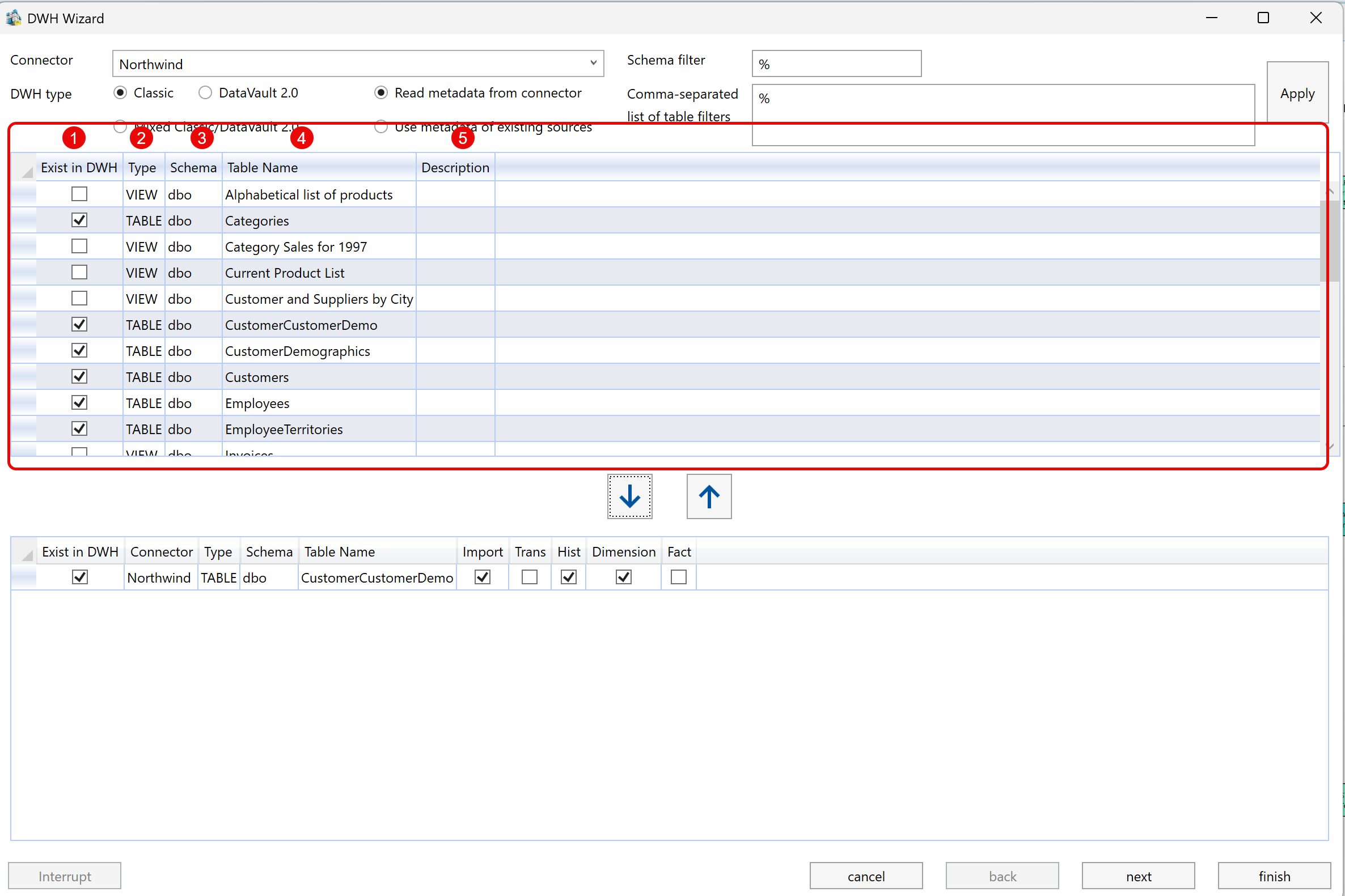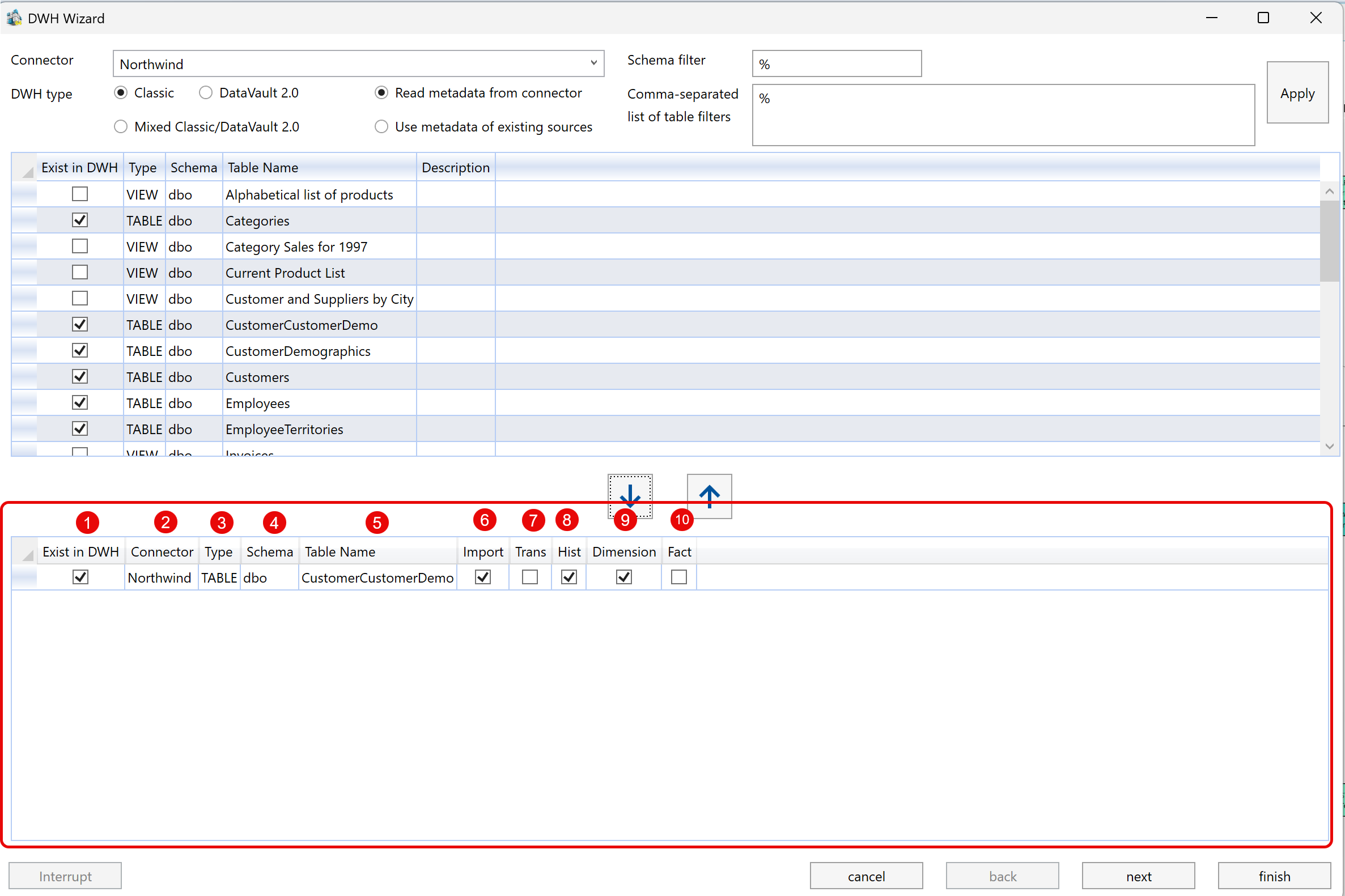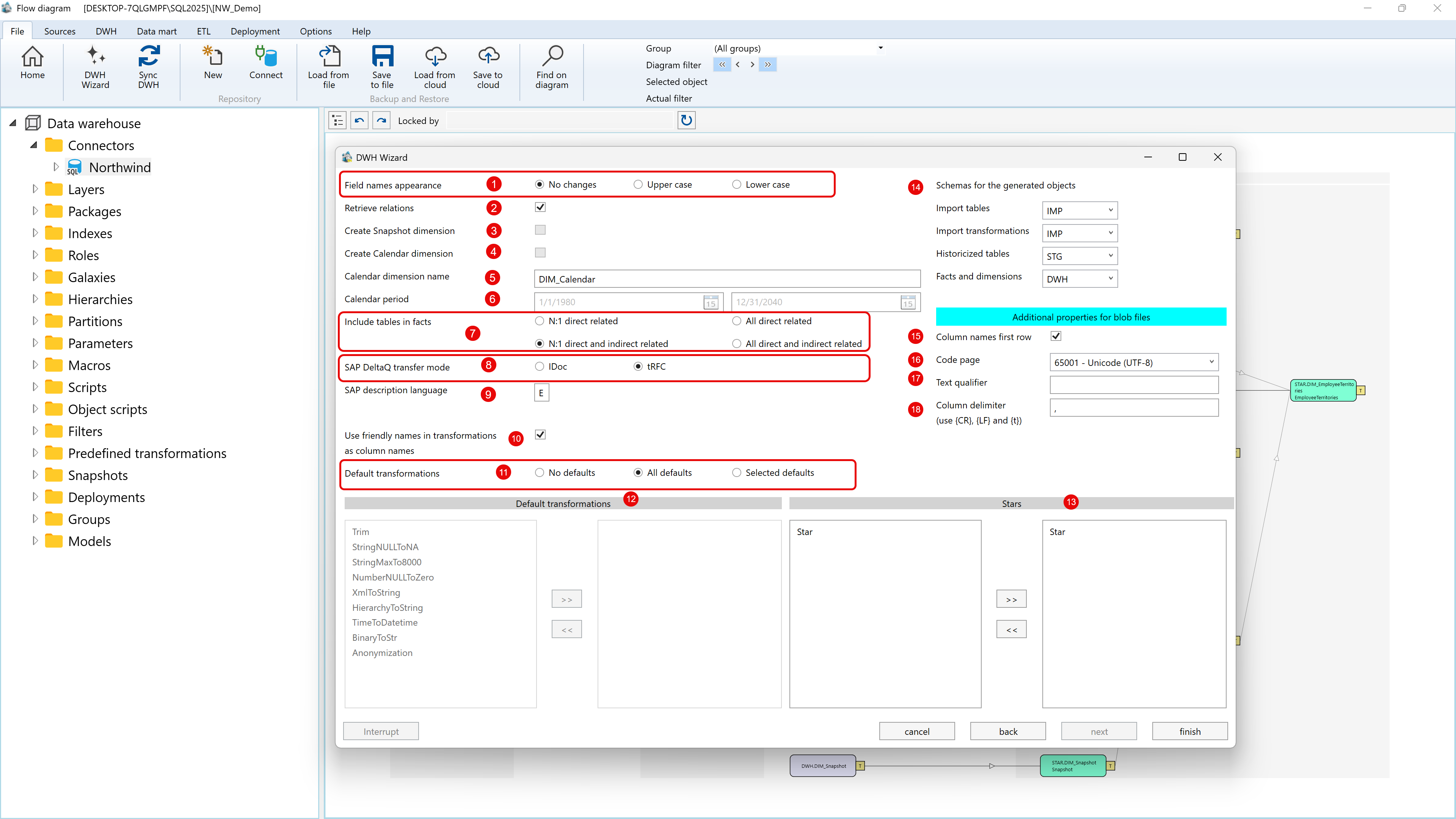DWH Wizard
The DWH Wizard
Launch from:
- Ribbon → File → DWH Wizard
- Canvas (right-click) → DWH Wizard
- Navigation Pane (right-click) → Connectors → DWH Wizard
The DWH Wizard in AnalyticsCreator provides a powerful, metadata-driven interface to import source structures and define how they will be transformed and loaded into your Data Warehouse. It supports classic dimensional modeling (Kimball), DataVault 2.0, and hybrid approaches.
How to Access the DWH Wizard
The DWH Wizard has 3 screens, the first screen is divided into three main sections:

A) Metadata Source and Filtering
This top section allows you to select the connector, choose the DWH modeling approach (Classic, DataVault 2.0, or Mixed), and configure metadata loading options. You can also apply schema and table filters to limit the imported metadata scope.
B) Source Object Selection
This middle panel displays all objects retrieved from the source. You can browse, search, and select the tables or views you want to include in your data warehouse model.
C) Object Configuration and Classification
Once selected, objects appear in this section where you can define how each should be processed—whether to import, apply transformations, enable historization, or classify them as dimensions or facts.
Description of Interface Elements
| ID | Property | Description |
|---|---|---|
| 1 | Connector | Connector used to obtain metadata. |
| 2 | DWH Type: Classic | Target architecture is dimensional/star schema (Kimball). |
| 2 | DWH Type: DataVault 2.0 | Target architecture is DataVault 2.0. |
| 2 | DWH Type: Mixed | Hybrid approach using Kimball model with DV2 elements (e.g., hash keys). |
| 3 | Read metadata from connector | Loads live metadata from the source. |
| 3 | Use metadata of existing sources | Uses previously imported metadata; required if the connection string is empty. |
| 4 | Schema filter | Limits metadata to a schema name or pattern (e.g., dbo, prod%). |
| 5 | Comma-separated list of table filters | Optional filter for table names using wildcards or specific names (e.g., BKPF, BSEG, %Sales%). |
| 6 | Apply | Executes metadata loading using the selected connector and filters. |

| ID | Column | Description |
|---|---|---|
| 1 | Exists in DWH | Read-only. Checked if the object already exists and will be refreshed. |
| 2 | Type | Object type (TABLE, VIEW, DELTAQ, ODP). |
| 3 | Schema | Schema name of the source object. |
| 4 | Table Name | Name of the source table or view. |
| 5 | Description | Marks the object for import. |

| ID | Column | Description |
|---|---|---|
| 1 | Exists in DWH | Read-only. Checked if the object already exists and will be refreshed. |
| 3 | Type | Object type (TABLE, VIEW, DELTAQ, ODP). |
| 4 | Schema | Schema name of the source object. |
| 5 | Table Name | Name of the source table or view. |
| 6 | Import | Marks the object for import. |
| 7 | Trans | Creates a transformation for the object after import. |
| 8 | Hist | Enables historization (SCD Type 2). |
| 9 | Dimension | Defines the object as a Dimension table. |
| 10 | Fact | Defines the object as a Fact table. |
Step 2: Define DWH Object Names
In this screen, you can override or rename the names of the DWH objects before generation.

| ID | Field Name | Description |
|---|---|---|
| 1 | Tables per package | Defines the maximum number of tables that will be grouped into a single SSIS or ADF package during deployment. |
| 2 | Import Package names | Template used for naming import packages. Variables like {CONNECTOR_NAME} and {NR} ensure unique and consistent naming. |
| 3 | Historizing Package names | Naming pattern for packages that handle historization (e.g., Slowly Changing Dimensions). |
| 4 | Table names | Naming convention template for physical table names generated in the DWH. |
| 5 | Transformation names | Defines how transformation objects (views, procedures, or logic layers) will be named. |
| 6 | Dimension names | Template for naming dimension objects derived from source tables. |
| 7 | Fact names | Naming convention for fact tables in the dimensional model. |
| 8 | HUB package name | Pattern for naming packages responsible for generating HUB entities (DataVault 2.0 only). |
| 9 | SAT package name | Template for naming packages that generate Satellite (SAT) entities. |
| 10 | LINK package name | Pattern used to name LINK package files (relationships between HUBs). |
| 11 | HUB transformation name | Naming convention for transformation logic related to HUBs. |
| 12 | SAT transformation name | Template used to name SAT transformation views or queries. |
| 13 | LINK transformation name | Defines naming pattern for transformations related to LINKs. |
| 14 | HUB table name | Naming format for physical HUB tables in the DWH. |
| 15 | SAT table name | Naming template for Satellite tables. |
| 16 | LINK table name | Format used to name LINK tables, which store relationships. |
| 17 | LINKSAT table name | Naming convention for Link-Satellite tables (hybrid structures in DV2.0). |
| 18 | Key field name | Pattern for foreign key field names, typically prefixed with FK_. |
| 19 | Calendar in facts name | Naming template for calendar-related foreign keys in fact tables. |
Step 3: Optional Attributes and Parameters
The third screen is where you define Optional Attributes and Parameters.

| ID | Attribute | Description |
|---|---|---|
| 1 | Field name appearance | Choose how field names appear: No changes / Upper case / Lower case. |
| 2 | Retrieve relations | Attempts to detect foreign key relationships from the source database. |
| 3 | Create Snapshot dimension | If enabled, creates a snapshot dimension (inactive if one already exists). |
| 4 | Create calendar dimension | If enabled, creates a calendar/time dimension (inactive if one already exists). |
| 5 | Calendar dimension name | Name of the calendar dimension to be created. |
| 6 | Calendar period | Start and end date for the calendar dimension. |
| 7 | Include tables in facts | N:1 direct related — Include directly N:1 related tables in the fact transformation. All direct related — Include all directly related tables in the fact transformation. N:1 direct and indirect related — Include both directly and indirectly related N:1 tables. All direct and indirect related — Include all directly and indirectly related tables. |
| 8 | SAP DeltaQ transfer mode | iDoc — Defines the transfer mode for SAP DeltaQ sources. t-RFC — Language used to retrieve descriptions from SAP. |
| 9 | SAP description language | Language used to retrieve descriptions from SAP. |
| 10 | Use friendly names in transformation as column names | If enabled, uses friendly names (if available) in generated transformation columns. |
| 11 | Default transformations | No defaults — No predefined transformation templates are used. All defaults — All predefined transformation templates will be applied. Selected defaults — Only the selected predefined templates will be applied. |
| 12 | Default transformations (list) | List of available transformation templates (used if “Selected defaults” is chosen). |
| 13 | Stars | Defines star schemas to create facts and dimensions. |
| 14 | Schemas for the generated objects | Specifies target schemas for each layer: • Import tables • Import transformations • Historized tables • Facts and dimensions |
| 15 | Column names first row | Blob-specific: Indicates that the first row of the file contains column headers. |
| 16 | Code page | Defines text encoding format (e.g., 65001 - Unicode UTF-8). |
| 17 | Text qualifier | Character used to wrap values in text fields (e.g., " or '). |
| 18 | Column delimiter | Delimiter used in blob files. Supports {CR} (Carriage Return), {LF} (Line Feed), and {t} (Tab). |
Now you're ready to generate your DWH objects with AnalyticsCreator.